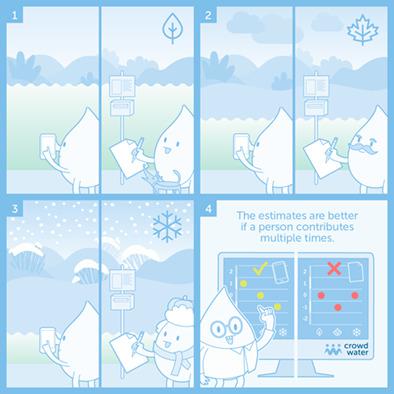当前位置:
X-MOL 学术
›
Hydrol. Process.
›
论文详情
Our official English website, www.x-mol.net, welcomes your feedback! (Note: you will need to create a separate account there.)
Quality and timing of crowd‐based water level class observations
Hydrological Processes ( IF 3.2 ) Pub Date : 2020-07-08 , DOI: 10.1002/hyp.13864 Simon Etter 1 , Barbara Strobl 1 , Ilja Meerveld 1 , Jan Seibert 1, 2
Hydrological Processes ( IF 3.2 ) Pub Date : 2020-07-08 , DOI: 10.1002/hyp.13864 Simon Etter 1 , Barbara Strobl 1 , Ilja Meerveld 1 , Jan Seibert 1, 2
Affiliation

|
Crowd‐based hydrological observations can supplement existing monitoring networks and allow data collection in regions where otherwise no data would be available. In the citizen science project CrowdWater, repeated water level observations using a virtual staff gauge approach result in time series of water level classes (WL‐classes). To investigate the quality of these observations, we compared the WL‐class data with “real” (i.e., measured) water levels from the same stream at a nearby gauging station. We did this for nine locations where citizen scientists reported multiple observations using a smartphone app and at 12 locations where signposts were set up to ask citizens to record observations on a paper form that could be left in a letterbox. The results indicate that the quality of the data collected with the app was better than for the forms. A possible explanation is that for each app location, a single person submitted the vast majority of the observations, whereas at the locations of the forms almost every observation was made by a different person. On average, there were more contributions between May and September than during the other months. Observations were submitted for a range of flow conditions, with a higher fraction of high flow observations for the locations were data were collected with the app. Overall, the results are encouraging for citizen science approaches in hydrology and demonstrate that the smartphone application and the virtual staff gauge are a promising approach for crowd‐based water level class observations.
中文翻译:

基于人群的水位观测的质量和时机
基于人群的水文观测可以补充现有的监测网络,并允许在没有其他数据的地区收集数据。在公民科学项目CrowdWater中,使用虚拟人员规方法反复进行水位观测会得出水位等级(WL级)的时间序列。为了调查这些观测的质量,我们将WL级数据与附近测量站同一河流的“实际”(即,实测)水位进行了比较。我们在9个地点使用公民智能手机应用程序报告了多个观察结果,在12个地点设置了路标,要求市民将观察结果记录在可以留在信箱中的纸质表格上。结果表明,与应用程序相比,通过应用程序收集的数据质量更好。可能的解释是,对于每个应用程序位置,只有一个人提交了绝大多数观察结果,而在表单的位置中,几乎每个观察结果都是由不同的人进行的。平均而言,5月至9月的捐款比其他月份多。提交了一系列流动条件的观测值,其中较高的高流量观测值是使用该应用程序收集的数据。总体而言,该结果对于水文学领域的公民科学方法是鼓舞人心的,并且表明智能手机应用程序和虚拟人员仪表是基于人群的水位观测的有前途的方法。而在表格的位置,几乎所有观察都是由不同的人进行的。平均而言,5月至9月的捐款比其他月份多。提交了一系列流动条件的观测值,其中较高的高流量观测值是使用该应用程序收集的数据。总体而言,该结果对于水文学领域的公民科学方法而言是鼓舞人心的,并证明了智能手机应用程序和虚拟人员仪表是基于人群的水位观测的一种有前途的方法。而在表格的位置,几乎所有观察都是由不同的人进行的。平均而言,5月至9月的捐款比其他月份多。提交了针对一系列流动条件的观测结果,其中使用应用程序收集数据的位置的高流量观测结果所占比例更高。总体而言,该结果对于水文学领域的公民科学方法而言是鼓舞人心的,并证明了智能手机应用程序和虚拟人员仪表是基于人群的水位观测的一种有前途的方法。在较高的高流量观测位置中,使用该应用收集了数据。总体而言,该结果对于水文学领域的公民科学方法而言是鼓舞人心的,并证明了智能手机应用程序和虚拟人员仪表是基于人群的水位观测的一种有前途的方法。在较高的高流量观测位置中,使用该应用收集了数据。总体而言,该结果对于水文学领域的公民科学方法而言是鼓舞人心的,并表明智能手机应用程序和虚拟人员仪表是基于人群的水位观测的一种有前途的方法。
更新日期:2020-07-08
中文翻译:

基于人群的水位观测的质量和时机
基于人群的水文观测可以补充现有的监测网络,并允许在没有其他数据的地区收集数据。在公民科学项目CrowdWater中,使用虚拟人员规方法反复进行水位观测会得出水位等级(WL级)的时间序列。为了调查这些观测的质量,我们将WL级数据与附近测量站同一河流的“实际”(即,实测)水位进行了比较。我们在9个地点使用公民智能手机应用程序报告了多个观察结果,在12个地点设置了路标,要求市民将观察结果记录在可以留在信箱中的纸质表格上。结果表明,与应用程序相比,通过应用程序收集的数据质量更好。可能的解释是,对于每个应用程序位置,只有一个人提交了绝大多数观察结果,而在表单的位置中,几乎每个观察结果都是由不同的人进行的。平均而言,5月至9月的捐款比其他月份多。提交了一系列流动条件的观测值,其中较高的高流量观测值是使用该应用程序收集的数据。总体而言,该结果对于水文学领域的公民科学方法是鼓舞人心的,并且表明智能手机应用程序和虚拟人员仪表是基于人群的水位观测的有前途的方法。而在表格的位置,几乎所有观察都是由不同的人进行的。平均而言,5月至9月的捐款比其他月份多。提交了一系列流动条件的观测值,其中较高的高流量观测值是使用该应用程序收集的数据。总体而言,该结果对于水文学领域的公民科学方法而言是鼓舞人心的,并证明了智能手机应用程序和虚拟人员仪表是基于人群的水位观测的一种有前途的方法。而在表格的位置,几乎所有观察都是由不同的人进行的。平均而言,5月至9月的捐款比其他月份多。提交了针对一系列流动条件的观测结果,其中使用应用程序收集数据的位置的高流量观测结果所占比例更高。总体而言,该结果对于水文学领域的公民科学方法而言是鼓舞人心的,并证明了智能手机应用程序和虚拟人员仪表是基于人群的水位观测的一种有前途的方法。在较高的高流量观测位置中,使用该应用收集了数据。总体而言,该结果对于水文学领域的公民科学方法而言是鼓舞人心的,并证明了智能手机应用程序和虚拟人员仪表是基于人群的水位观测的一种有前途的方法。在较高的高流量观测位置中,使用该应用收集了数据。总体而言,该结果对于水文学领域的公民科学方法而言是鼓舞人心的,并表明智能手机应用程序和虚拟人员仪表是基于人群的水位观测的一种有前途的方法。


























 京公网安备 11010802027423号
京公网安备 11010802027423号